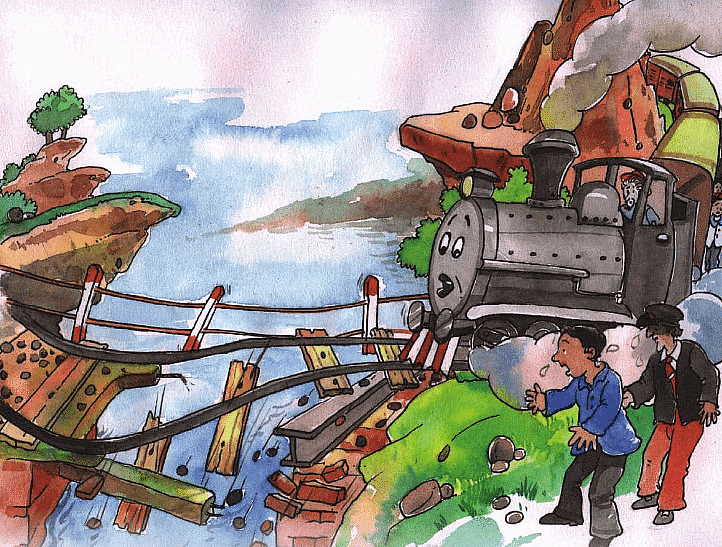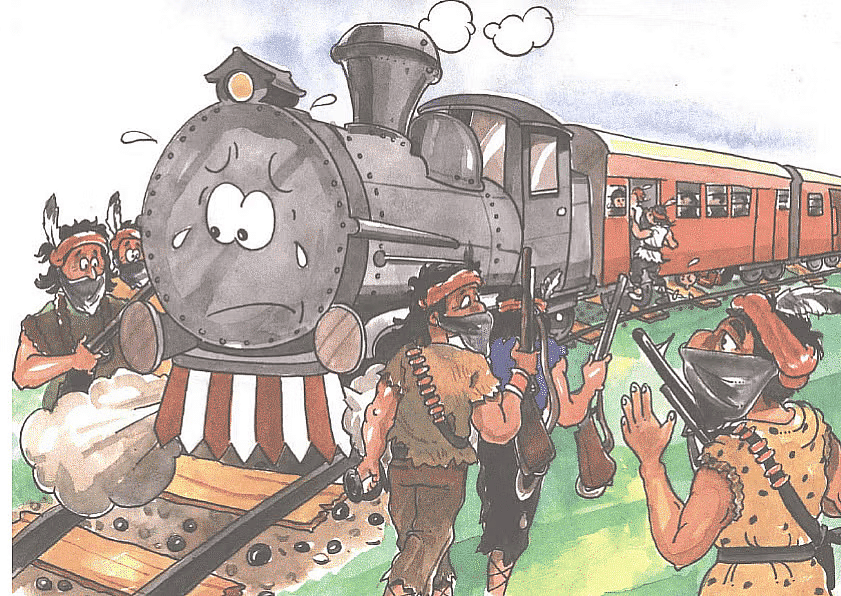Worksheet Solutions: Around the World | English Marigold Class 5 PDF Download
Q1: Multiple Choice Questions (MCQs)
(i) What interrupted the train's journey on the way to New York?
(a) A landslide
(b) A herd of buffaloes
(c) A broken bridge
(d) An engine malfunction
Ans: (b)
The train was forced to stop when a massive herd of buffaloes crossed the railway track, making it impossible for the train to proceed. The buffaloes took three hours to pass, delaying the journey significantly.
(ii) Why did the train stop the second time during its journey?
(a) A broken bridge
(b) A storm
(c) The train ran out of coal
(d) An attack by the Sioux Indians
Ans: (a)
The train stopped for the second time because the bridge near Medicine Bow was damaged and couldn't support the weight of the train. The passengers had to cross the bridge at maximum speed to avoid disaster.
(iii) How did Passepartout save the train from the attack?
(a) He fought the Sioux Indians
(b) He signaled for help
(c) He separated the engine from the coaches
(d) He derailed the train
Ans: (c)
When the Sioux Indians attacked the train, Passepartout bravely crawled under the moving train and separated the engine from the coaches to help slow it down and prevent further danger to the passengers.
(iv) What was the most dangerous part of the journey for the train?
(a) Crossing a desert
(b) Passing through the mountains
(c) Passing through a tunnel
(d) Travelling over a weak bridge
Ans: (d)
The most dangerous part of the journey was when the train had to cross a weak suspension bridge. The bridge was already damaged, and the train had to speed up to cross it before it collapsed.
 (v) How long did it take the train to cross the United States from the Pacific to the Atlantic?
(v) How long did it take the train to cross the United States from the Pacific to the Atlantic?
(a) 10 days
(b) 7 days
(c) 5 days
(d) 12 days
Ans: (b)
According to the story, it took seven days for the train to travel from the Pacific Ocean to the Atlantic Ocean, covering the distance from San Francisco to New York.
Q2: Fill in the Blanks
(i) The train was forced to stop because a ______ of buffaloes blocked the track.
Ans: herd
(ii) Passepartout saved the train by separating the ______ from the coaches.
Ans: engine
(iii) The passengers were attacked by the ______ Indians.
Ans: Sioux

(iv) The bridge collapsed into the river ______ the train passed over it.
Ans: after
(v) The train passed the highest point of its journey at ______ feet above sea level.
Ans: 7524
Q3: True or False
(i) The train was stopped by a herd of buffaloes on the track.
Ans: True
The train was indeed stopped by a large herd of buffaloes crossing the tracks, which delayed the journey for three hours.
(ii) Passepartout was an American passenger on the train.
Ans: False
Passepartout was not American; he was French. He was travelling as Phileas Fogg’s servant.
(iii) The broken bridge could easily support the weight of the train.
Ans: False
The bridge near Medicine Bow was severely damaged, and it could not support the train's weight under normal conditions. The train had to cross it at maximum speed to avoid falling into the river.
(iv) The Sioux Indians attacked the train with rifles.
Ans: True
The Sioux Indians were armed with rifles when they attacked the train. Some of the passengers defended themselves using revolvers.
(v) The train crossed the bridge slowly to prevent damage.
Ans: False
The train crossed the broken bridge at maximum speed, not slowly. The quick crossing was necessary to prevent the bridge from collapsing under the train's weight.
Q4: Match the Following

Ans:
(a) Steep mountain slopes – (5) Difficult terrain
The train had to pass through steep mountain slopes, which made the journey difficult and dangerous.
(b) Sioux Indians – (1) Attacked the train
The train was attacked by Sioux Indians, who jumped onto the moving train and engaged in a confrontation with the passengers.
(c) Buffalo herd – (4) Blocked the train's path
A large herd of buffaloes blocked the railway track, forcing the train to stop until the herd had passed.
(d) Passepartout – (3) Separated the engine from the coaches
Passepartout heroically separated the engine from the coaches to protect the passengers during the Sioux attack.
(e) Broken bridge – (2) Collapsed after the train crossed
The bridge near Medicine Bow collapsed into the river after the train had crossed it, demonstrating the danger posed by the damaged structure.
Q5: Short Answer Questions
(i) Why did the train stop when the herd of buffaloes appeared?
Ans: The train had to stop because a large herd of buffaloes was crossing the tracks, and the train couldn't proceed until they passed.
(ii) How did Passepartout manage to separate the engine from the rest of the train?
Ans: Passepartout crawled underneath the racing train, holding onto the chains, and carefully made his way to the engine to separate it from the rest of the train.
(iii) What happened to the bridge after the train passed over it?
Ans: The bridge collapsed into the river below after the train had safely crossed over it.
(iv) Who attacked the train as it continued its journey after crossing the bridge?
Ans: The train was attacked by the Sioux Indians, who jumped onto the moving train and tried to stop it.
(v) What was the highest point of the train's journey?
Ans: The highest point of the journey was 7524 feet above sea level as the train passed through the Rocky Mountains.
|
22 videos|156 docs|67 tests
|
FAQs on Worksheet Solutions: Around the World - English Marigold Class 5
| 1. What are the main continents covered in the "Around the World" lesson for Class 5? |  |
| 2. How can students effectively remember the capitals of different countries? |  |
| 3. What are some interesting facts about wildlife in different countries? |  |
| 4. How does learning about different cultures benefit students? |  |
| 5. What activities can teachers use to make the "Around the World" lesson more engaging? |  |





















